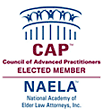Divorce Mediation

Family Law Services
(Continued)
Divorce Mediation 101
Couples who are facing the difficult prospect of divorce have a critical decision to make: whether to pursue the divorce using the “traditional” litigation model; or whether to consider an alternative model, such as divorce mediation.
Arriving at the correct decision should include an analysis of the potential costs of traditional litigation. The most obvious cost of litigation is the time and legal fees involved in going to court. A less obvious but equally important cost is the adversarial, stressful and sometimes public nature of the process, which may include motions and a trial, as well as appeals. Consideration of these costs is all the more compelling in cases involving children; the divorcing parents often seek to spare their children “the heartbreak of having their innermost feelings about their parents — even if reviewed in camera, forensically analyzed.”1
Moreover, with traditional litigation, the parties lack control over the ultimate outcome of their dispute — this decision is placed in the hands of a judge, who might have a very different outlook on the parties’ needs, obligations and values. Indeed, a key benefit of alternative models of dispute resolution is the parties’ retaining the element of self-determination: “[s]ettlements permit parties to resolve disputes on mutually acceptable terms rather than exposing themselves to the uncertainties of litigation.”2
Our courts recognize “the right of competent, informed citizens to resolve their own disputes in whatever way may suit them. Clients have the right to make the final decision as to whether, when, and how to settle their cases and as to the economic and other positions to be taken with respect to issues in the case.”3 When couples consider pursuing mediation to resolve their divorce, they should do so understanding the specifics of this model.
Mediation is generally recognized as a process in which the divorcing parties (often on their own, but sometimes represented by separate attorneys) attempt to negotiate a divorce agreement with the assistance of a neutral third party, the mediator (who may or may not be an attorney, but who does not represent either party).
There are various “models of practice” within the field of mediation. With the “facilitative model,” the mediator is “in charge of the process,” but the parties “retain responsibility for the product.”4 The facilitative mediator refrains from providing advice, recommendations, or information about likely legal outcomes; instead, the mediator’s focus is on facilitating and guiding the parties in their own conflict resolution. In the “evaluative model” of mediation, the mediator provides the parties with his or her substantive knowledge and experience, and focuses on evaluating and settling the dispute.5 The “transformative model” of mediation involves a mediator who “works with the parties to help them change the quality of their conflict interaction from negative and destructive to positive and constructive, as they explore and discuss issues and possibilities for resolution.”6 In transformative mediation, the focus is on transforming the parties’ communications and interactions; a settlement of the conflict is a byproduct of that transformation.7
Different mediators employ different models of mediation, or combinations of models. However, as a general proposition,
The ultimate authority in mediation belongs to the parties. With the help of the mediator, the parties may consider a comprehensive mix of individual needs, interests, and whatever else they deem relevant, irrespective of rules of evidence or legal precedent. Unlike the adjudicatory process, the emphasis is not on who is right and who is wrong but on establishing a workable resolution that best meets the needs of the participants.8
In The Fundamentals of Family Mediation9, John M. Haynes recommends a specific framework for divorce mediation. Following the initial “intake” session, Haynes recommends the following series of sessions:
- The Budget and Support Session
Prior to this session, the parties are given a questionnaire detailing their income from the prior year, and a budget for the upcoming year. During the session, both parties’ income and expense information is shared, and the parties make decisions regarding how much each party will need to live for the following year. This session typically focuses on ways to close budget gaps, by increasing income, decreasing expenses, or liquidating assets.10 - The Division of Property Session
Prior to the session, the parties will provide an outline of all assets and liabilities. What follows is a process involving the identification of assets; an evaluation of each asset (including such things as whether the asset is liquid or non-liquid, income-producing or not; and tax issues involved); a valuation of the assets; and a division of the assets.11 - The Parenting Session
The parenting session addresses all issues affecting the child(ren), including custody/residency, visitation, education, health, and extended family issues.12 Resolution of these issues sometimes involves revisiting the budget/support and division of property agreements.13
When support, property division and parenting issues have been agreed upon by the parties, the mediator prepares a Memorandum of Understanding, which outlines the parties’ agreement in plain terms. The parties review the Memorandum of Understanding with their separate counsel and the document is ultimately incorporated into the judgment of divorce.14
Of course, every mediator and every divorcing party approaches the process of mediation in a slightly different manner. However, the process of mediation is an alternative that may allow divorcing parties “an opportunity to expeditiously resolve their conflicts without the cost and burden of plowing thought the adversarial system to achieve a final result so that they [can] move on with their lives.”15
1 N.H. v. H.H., 418 N.J. Super. 262, 280 (App. Div. 2011).
2 Id. at 279 (quoting Ocean County Chapter. Inc. of Izaak Walton League of America v. Department of Environmental Protection, 303 N.J. Super. 1, 10 (App. Div. 1997)).
3 Lerner v. Laufer, 359 N.J. Super. 201, 216 (App. Div.), certif. denied, 177 N.J. 223 (2003) (quoting Pressler,Current N.J. Court Rules, Appendix XVIII (2003)).
4 Folberg, J., Milne, A. and Salem, P., Divorce and Family Mediation: Models, Techniques and Applications, (Guilford Press, NY 2004), at p. 14.
5 Id. at p. 14-15.
6 Id. at p. 6.
7 Id. at p. 16.
8 Id. at p. 8.
9 (State University of New York Press, Albany, 1994).
10 Haynes, pp. 67-79.
11 Id. at p. 92.
12 Id. at p. 117.
13 Id. at p. 117-154.
14 Id. at 187.
15 N.H., supra, 418 N.J. Super. at 290 (quoting Lehr v. Afflito, 382 N.J. Super. 376, 398 (App. Div. 2006).








Vanarelli & Li, LLC on Social Media